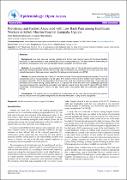Prevalence and factors associated with low back pain among healthcare workers in kibuli Muslim hospital kampala, Uganda
Abstract
Background: Low back pain was not only considered to be the most common reason for functional disability
worldwide, but also estimated to have affected 90% of the universal population. This study aimed at determining the
prevalence, consequences and socio-demographic factors associated with low back pain.
Methods: A cross-sectional survey was employed and a total number of 150 self-structured questionnaires were
distributed among healthcare workers and this was used to determine the prevalence of low back pain and work
related absenteeism. Data was entered using Epi info soft-ware and analyzed using SPSS.
Results: An overall response rate of 84% (n=140) was achieved. The study established that majority (37%) of the
respondents were in the age bracket of 20-39 years, 57% female (n=59) and 64% of them were married. the pint
prevalence was 84%, 31% of the respondents took leave from work as a result of low back pain. There was high
prevalence of sick leave among nursing staff 45.2%, Chi-square test shows that there was a statistically significant
association between the respondents occupations and daily time spent during their work (P value 0.011 and 0.042)
respectively. Socio-demographic factors like age, marital status and gender were not statistically significant at
P<0.05.
Conclusions: The medical and socio-professional consequences of low back pain among healthcare workers
was as a result of their occupation designations and the daily time spent in carry out this occupations.
Collections
- Research Papers [57]

